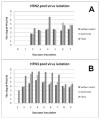Transmission of avian influenza A viruses among species in an artificial barnyard
- PMID: 21483843
- PMCID: PMC3069003
- DOI: 10.1371/journal.pone.0017643
Transmission of avian influenza A viruses among species in an artificial barnyard
Abstract
Waterfowl and shorebirds harbor and shed all hemagglutinin and neuraminidase subtypes of influenza A viruses and interact in nature with a broad range of other avian and mammalian species to which they might transmit such viruses. Estimating the efficiency and importance of such cross-species transmission using epidemiological approaches is difficult. We therefore addressed this question by studying transmission of low pathogenic H5 and H7 viruses from infected ducks to other common animals in a quasi-natural laboratory environment designed to mimic a common barnyard. Mallards (Anas platyrhynchos) recently infected with H5N2 or H7N3 viruses were introduced into a room housing other mallards plus chickens, blackbirds, rats and pigeons, and transmission was assessed by monitoring virus shedding (ducks) or seroconversion (other species) over the following 4 weeks. Additional animals of each species were directly inoculated with virus to characterize the effect of a known exposure. In both barnyard experiments, virus accumulated to high titers in the shared water pool. The H5N2 virus was transmitted from infected ducks to other ducks and chickens in the room either directly or through environmental contamination, but not to rats or blackbirds. Ducks infected with the H7N2 virus transmitted directly or indirectly to all other species present. Chickens and blackbirds directly inoculated with these viruses shed significant amounts of virus and seroconverted; rats and pigeons developed antiviral antibodies, but, except for one pigeon, failed to shed virus.
Conflict of interest statement
Figures



References
-
- Rohm C, Zhou N, Suss J, Mackenzie J, Webster RG. Characterization of a novel influenza hemagglutinin, H15: criteria for determination of influenza A subtypes. Virology. 1996;217:508–516. - PubMed
Publication types
MeSH terms
Grants and funding
LinkOut - more resources
Full Text Sources
Medical

